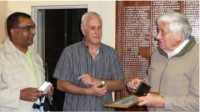
A special gift from Anthony Govender
A few weeks ago I received an email from Anthony Govender saying that he had put an item in the mail that he felt I would appreciate. I had no idea at this time of the significance of the gift that Anthony sent me.
The gift came with a covering letter from Anthony which speaks for all of us - extracts below. (Govender's original letter at this link)
Image right: Anthony Govender and Keith Murray with Prof Clive Graham
I have realized that numismatics is more than just collecting coins. Numismatics is also about the people you meet and the things you learn during this journey. I have certainly met a lot of wonderful people and learnt a lot of new and exciting things that has just broadened my knowledge and made me a better person...
As a token of my sincerity, I have decided to let you have something that I have had for a long time and it is certainly something that belongs with you...
The "something" was the original copy of "Kence, the trade tokens of Strachan and Company" used to publish the now sought after books which were hand published by Prof Clive Graham and I in the late 1970s.
Let me tell you why this gift from Anthony is so significant to me.
On Thursday 28th April 1977 I gave a talk entitled "The token coins of Strachan and Co" to the members of the Pietermaritzburg Numismatic Society. The talk followed months of research on the coins largely through the help of Ken Strachan, the General Manager of the large sprawling company that had dominated trade in East Griqualand for about a century. After the talk Clive approached me and suggested we produce a book on the coins. I thought it was an excellent idea and so "Kence, the trade tokens of Strachan and Company" was born.
I first came across the Strachan and Co coins in 1976 while working at the Barclays Bank agency at Umzimkhulu (our bank's base was Ixopo). The story behind my introduction to the coins is fully detailed on my website so I won't repeat it here. These were turbulent times as the Nationalist Party carved up South Africa into a series of "independent" African homelands including the Transkei (formerly East Griqualand). One of the casualties of the new homeland policy were the white trading stores which were forcibly sold to new African proprietors. For a business as large as Strachan and Co, with over twenty trading stores across the region, the transition took nearly ten years as its stores were slowly sold off into the early 1980s.
Amidst all this chaos there was one further complication for this young bank clerk. I had a British Passport and as a result of the region's change in status following independence I had to visit the new customs post on the banks of the Umzimkhulu River every time I went to the bank agency. The man in charge of the customs post was a very obnoxious African man who definitely recognized and fully enjoyed the power that he had been entrusted with. Despite my pleas for a special dispensation he made me come into the customs post every day, fill in forms and have my passport stamped - on arrival and departure from my visit to the bank agency at Umzimkhulu. (South African passport holders were simply waived through after a brief ID check because South Africa recognized the Transkei as an independent state. And so for three weeks I left the bank in Ixopo an hour early, stood in queues then worked at the agency before departing, once again standing in queues and then arrived back in Ixopo an hour late. The dangers to myself and my African workmate each day in a bank van loaded with cash cannot be underestimated.
Image right: Prof Clive Graham who passed away in June 2010
But life has a wonderful way of balancing up the ledger - it was the first payday for the new Transkei bureaucrats (including the customs post chief). You see they had to come to my little bank agency to cash in their cheques and withdraw money. On that day the queue outside my small toilet-sized agency was particularly long as dozens of government employees waited to cash in their cheques. The customs man arrived, as bright as a button, dressed in his impressive customs uniform. Once again his status was clearly apparent as he walked to the front of the queue and calmly put his savings book in front of me. I looked at him and said "Could you please join the back of the queue". A look of horror passed briefly over his face as he looked back at the queue but he realized that he had no option. An hour later his turn came and standing in the heat of the hot morning sun had transformed his impressive uniform into a sweaty mess. I looked at his deposit and noted that he had not put in all the details required by the bank to accept it. "I am sorry sir but you will have to join the enquiries queue as there is a mistake on your deposit", I said. (Now normally I would just fix it but I had an ulterior motive in mind). The customs chief looked at the length of the enquiries queue with horror and tried to push in at the front. My single African workmate who handled the enquiries was not known for his speed in doing so. "I am sorry sir, but you will have to join the back of the queue", I said. Not wanting to cause a stir he meekly complied and nearly two hours later he reached the front of the enquiries queue. It was approaching lunch time during which period the bank agency would close for half an hour while I ate my sandwiches and drank some luke warm tea. By now the queue waiting to do their banking had extended quite dramatically and the customs man once again in desperation tried the jump the queue trick. "Sorry sir, you will have to join the back of the queue," I said. His brief 9am visit to the bank had now extended to past midday as I closed the agency's bank doors. As I ate my lunch I watched with some morbid pleasure through the small window as he stood at the end of the queue, cap in hand, mopping his head with a cloth soaked in sweat and obviously boiling in what had started out as being an impressive uniform. After lunch the doors opened and at about 2pm the customs officer arrived before my counter again.
"Now what are we going to do about the time I spend each day filling in forms so that I can run this bank agency?" I said. "I can make you wait five hours each time you come to the bank to draw money or I can give you special privileges and let you be served first. What would you prefer?"
Image right: Well known South African numismatist Anthony Govender
Well the question was self-serving I know but what happened was the customs chief suggested, with a stroke of genius, that I have a secret password. So the word "BANK" became my special access key which I would simply say through the window of my bank van to work or my private car to visit Ken Strachan while researching the Strachan and Co coins. The word put the fear of G-o-d in the eyes of the lesser mortals working at the customs post and I was quickly ushered through, avoiding any of the formalities faced even by the South African passport holders. I never even had to show my passport. And so it was that all times of the day or night I used the word BANK and my friend, the customs chief, jumped the queue from that day on.
These were some of the factors that played a role in the research I did on the S&Co. For example, every Wednesday afternoon (we did not work then) I would travel to Umzimkhulu to get a few more containers of the coins which I would then take back to my rental house in Ixopo. I would carefully wash each coin individually in my bath with warm water and soap (yes the white ceramic became brown after a while), identify each of the coins (including the new "In Goods" set which had previously gone unnoticed) before putting them back into the containers a week later and getting the next batch. The whole process, working every evening for several hours, took me six months to complete. This resulted in an accurate identification and categorization of over 20,000 pieces as seen in the book "Kence". It was during this process that I came across about fifty F C Larkan coins stored in a small white canvas bag placed on the top of the S&Co pieces in one of the metal containers. The F C Larkan story can be seen at this link.
It was through this hands-on research on categorizing the S&Co coins and discussions with Ken Strachan on the coins that the book "Kence, the trade tokens of Strachan and Co" was published in partnership with Prof Clive Graham who undertook most of the research into the company's interesting historical background.
The book, based on our joint research, was typed up by Clive's secretary at the University of Natal and after this task was completed Clive gave me a copy of the draft for editing when I came down to a meeting at the Pietermaritzburg Numismatic Society.
Following these final edits the book was run off on a University photocopier with Clive and I paying the related costs of about ZAR50. So the significance of the gift from Anthony Govender of the original copy of "Kence" from which copies of the pages were printed can now be fully understood. It was over thirty years ago that I last handled them and yes my history is strongly linked to them!
Here are some of the pages of the original "Kence" book:
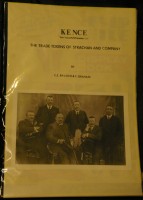
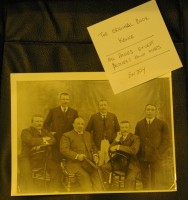
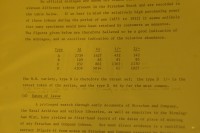
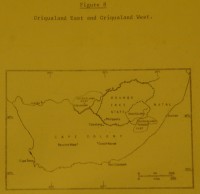
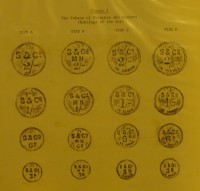
Before binding "Kence" from these pages Clive and I spread one hundred copies of the book across a large room at a time compiling each book page-by-page by hand. Interestingly Clive and I hand bound each copy of the book using two staples and a paper overlay to cover the staples - a very time consuming task. We soon realized that the thin white paper overlay we originally used was inferior so we then used a stronger yellow fabric-type material on all later copies. The white paper covered staples represent the first few copies bound and are much rarer than the yellow fabric bound copies. The rust from the staples is now common and can be seen through the white paper bound copies. I have about a dozen copies of "Kence" left from the original publication (including both types of binding). Exactly 1,000 copies were published.
The first ten copies (white paper backing) were numbered and signed by Clive, myself and Ken Strachan under his company stamp and given to close friends and family. I took these copies to Ken one Wednesday afternoon and watched as he stamped and signed each copy. A further thirty copies of the book were purchased by Ken Strachan and given to directors of Strachan and Co with a hand written message from Ken Strachan.
Here is a scan of Ken Strachan's letter ordering 30 copies:
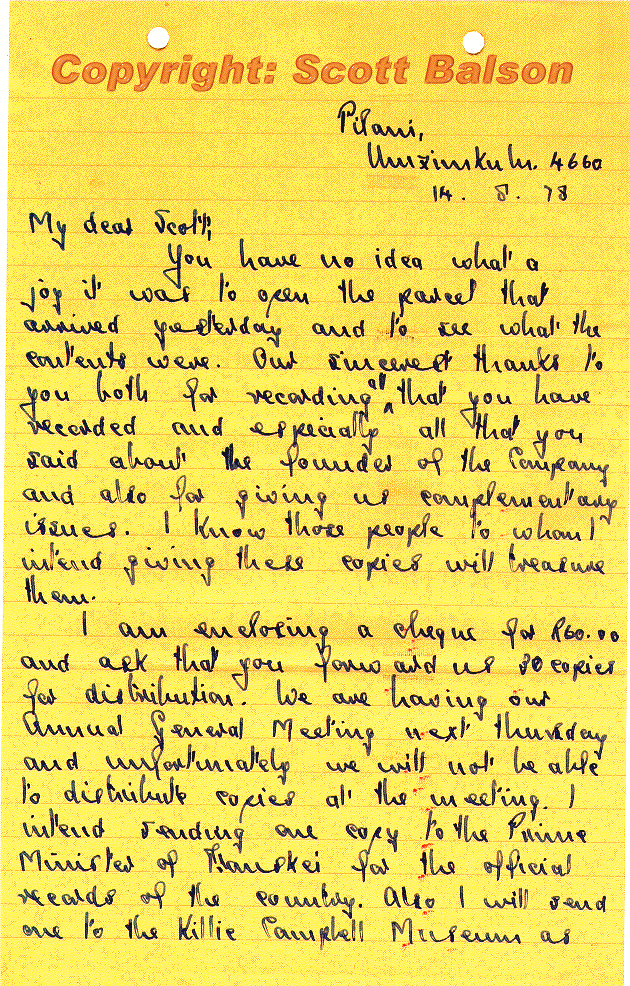
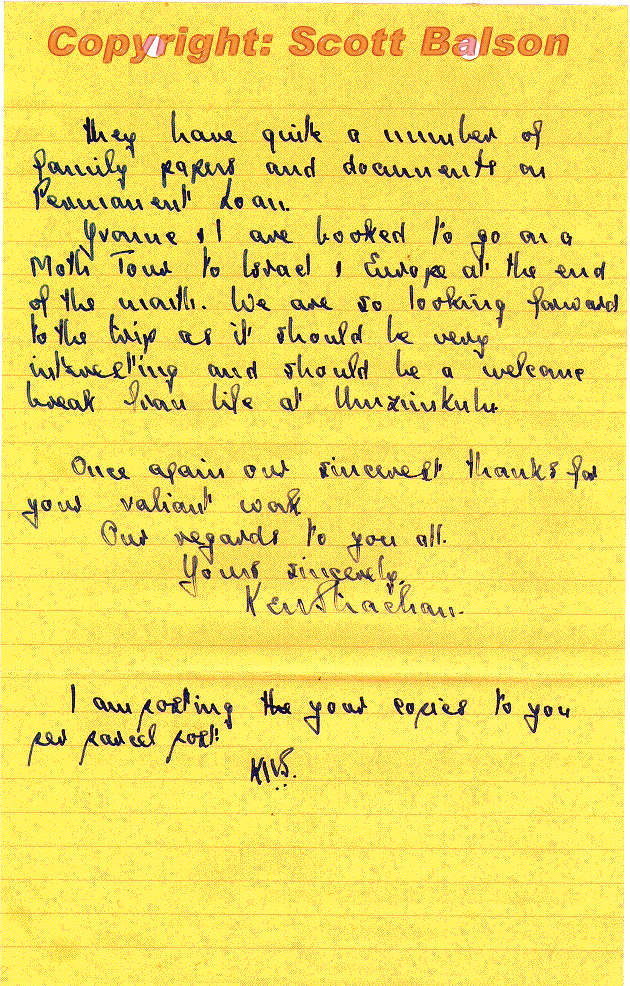
We sold about 60 other copies of the book for just ZAR2 each (largely to university libraries). Dr Frank Mitchell and Dr Theron were among the people who purchased copies. After about a year, when sales had slowed right down, I purchased the remaining 900 copies published from Clive at an agreed price.
I had a farm at Champagne Castle in the early 1980s and stupidly placed most of the remaining copies of the book in a thatched shed on the farm. I thought they would be secure there but a vandal burnt down the shed and all the copies stored there were lost meaning that only about 150 copies of the original "Kence" have survived.
While the publication of the book was, for me, a financial disaster (when one considers the costs and returns) the joy I had in accomplishing this work together with Prof Clive Graham was one of the highlights of my numismatic hobby!
In 1996 I established a small website based on "Kence" - now, many years later, this website (you are looking at now) encompasses a whole range of related subjects on South African coins and led to the 2007 publication of my book "Children of the Mist". Like "Kence" the time taken in compiling this research on my website has been a financial disaster but the joy in what I have accomplished remains a highlight of my interest in numismatics. Sales of "Children of the Mist", inspired by the Strachan and Co coins and "Kence" has certainly made up for any financial shortfall!
In closing, in 2002 Lia Kruger, branch manager of the Standard Bank in Kokstad, contacted me by email to ask if she could use some images from my website of the Strachan coins. I was astounded when she confirmed to me that she had records from the bank which factually proved that the coins had been used as currency by the bank in Kokstad in the 1870s and later when the first building was but a tent and currency of the crown in the region was all but non-existent in the region. The establishment of the bank branch in Kokstad followed the annexation of East Griqualand by the Governor of the Cape Colony.
The 125th anniversary of the Kokstad Branch of the Standard Bank can be seen at this link. In this brochure Lia talks about the Strachan and Co coins.